Based on anthropometric data and other human factors, ergonomics is the study of the relationship of people to their environment. Ergonomic design is the application of human factors data to the design of products and spaces to improve function and efficiency. Universal design builds on ergonomics to improve the use of products, spaces, and systems equally for people of a variety of size, ages, and abilities. This basis for the design guidelines and access standards, as well as applications, are detailed in chapter 6, "Bathroom Planning," and throughout this book.
This discussion should help drive home the point that universal design is much more than the misconception that it is design limited to medical solutions for access challenges.
History and State of the Art
Since the end of World War II, awareness of the need for improved access and universal design has been growing. Currently, we are experiencing unprecedented interest, worldwide, in the design of environments and products that respect the diversity of human beings. Nowhere is this more true than in the bathroom (and kitchen) encompassing activities of daily life critical to everyone.
People are living longer, largely due to healthier lifestyles, better medicine, and vaccines and sanitation, which have virtually eliminated many deadly infectious diseases. According to the U. S. Census Bureau, life expectancy is projected to be 79.5 years for those born in 2012. We are redefining retirement to encompass active adult living, and our designs must include the support that will enable active lifestyles. In addition, more people are living with disabilities and they want to live better. There is a huge population of veterans with disabilities. Antibiotics and other medical advances have enabled people to survive accidents and illnesses that were previously fatal.
According to the U. S. Census Bureau’s Survey of Income and Program Participation (SIPP), in 2005, approximately 19 percent of the population had some level of disability, and approximately 12 percent had a severe disability. In addition, the National Center for Injury Prevention and Control estimates that one out of three adults 65 or over falls each year. In short, in response to our current society, universal design concepts must be applied to planning a bathroom so that it will function for, and benefit, all the residents of, and visitors to, a home.
Ron Mace, FAIA, known as the father of universal design, defined it as "the design of products and environments to be usable by all people to the greatest extent possible." From 1994 to 1997, Mace led a research and demonstration project at the Center for Universal Design at NC State University, funded by the U. S. Department of Education’s National Institute on Disability and Rehabilitation Research (NIDRR), which included the development of universal design guidelines or principles.
Following is that current list of the Seven Principles of Universal Design with design applications for the bathroom. You might find these principles a good checklist to use in the design process, as additional criteria when choosing between options
1. Equitable Use
The design is useful and marketable to people with diverse abilities. Design provides the same means of use for all users: identical whenever possible; equivalent when not. It avoids segregating or stigmatizing any users (see Figure 4.12). Provisions for privacy, security, and safety should be equally available to all users. Also, the design should be appealing to all users.
Design applications include the visit-able guest bathroom, center-mounted lavatory faucets, grab bars, tall storage, rocker light switches, an automatically opening toilet, and motionsensor lighting, ventilation, and water at the vanity.
2. Flexibility in Use
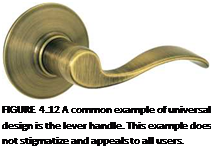 The design accommodates a wide range of individual preferences and abilities. It provides choice in methods of use and accommodates right – or left-handed access and use. The design facilitates the user’s accuracy and precision. And it provides adaptability to the user’s pace. Design applications include a removable (see Figure 4.13) or built-in tub seat and reinforcement for, or installation of, multiple grab bars to support tub or shower use by a seated or standing user. Other applications include grab bars for use in a horizontal or vertical position, or that can be folded down out of the way.
The design accommodates a wide range of individual preferences and abilities. It provides choice in methods of use and accommodates right – or left-handed access and use. The design facilitates the user’s accuracy and precision. And it provides adaptability to the user’s pace. Design applications include a removable (see Figure 4.13) or built-in tub seat and reinforcement for, or installation of, multiple grab bars to support tub or shower use by a seated or standing user. Other applications include grab bars for use in a horizontal or vertical position, or that can be folded down out of the way.
|
|
|
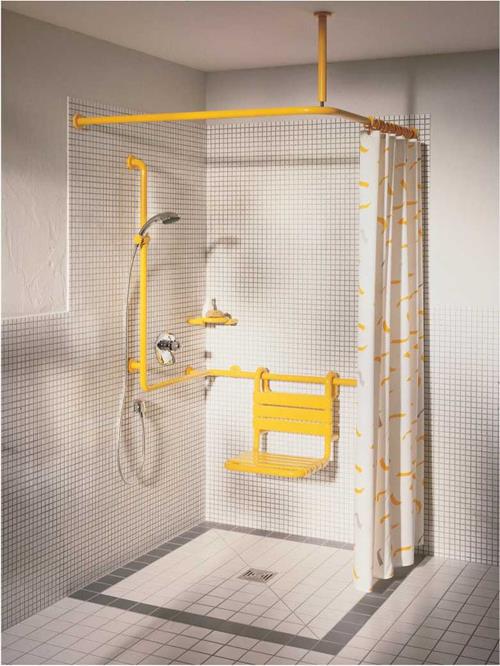
3. Simple and Intuitive Use
The design is easy to understand, regardless of the user’s experience, knowledge, language skills, or current concentration level. It eliminates unnecessary complexity and is consistent with user expectations and intuition. The design accommodates a wide range of literacy and language skills. It arranges information consistent with its importance. Also, it provides effective prompting and feedback during and after task completion.
Design applications include single-lever faucet operation that is left for hot and right for cool, or the use of red to indicate hot and blue to indicate cold (see Figure 4.14 and 4.15).
4. Perceptible Information
The design communicates necessary information effectively to the user, regardless of ambient conditions or the user’s sensory abilities. It uses different modes (pictorial, verbal, tactile) for redundant presentation or redundant cuing of essential information. The design provides adequate contrast between essential information and its surroundings. It maximizes "legibility” of essential information. It differentiates elements in ways that can be described (i. e., makes it easy to give instructions or directions). Also, it is compatible with a variety of techniques or devices used by people with sensory limitations.
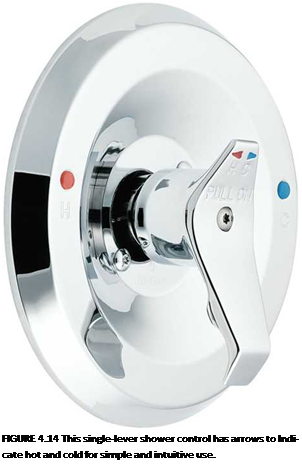 |
 |
Design applications include open or visible storage, a digital temperature control that both makes a sound and blinks when temperature limits are reached, or lighting controls that light up in the "off” position and go dark when the light is on (see Figure 4.16).
5.
 |
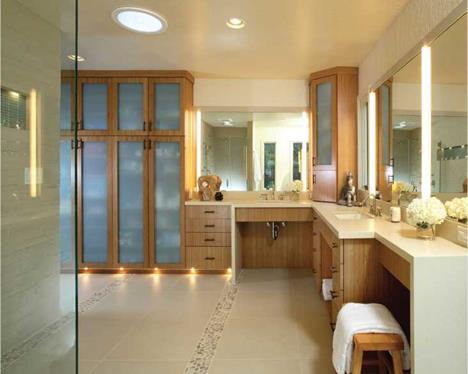 |
Tolerance for Error
The design minimizes hazards and the adverse consequences of accidental or unintended actions. It arranges elements to minimize hazards and errors, with the most-used elements being the most accessible, and hazardous elements eliminated, isolated, or shielded. The design provides warnings of hazards and errors, and fail-safe features. It discourages unconscious action in tasks that require vigilance.
Design applications include GFCI receptacles that reduce the risk of shock, temperature-limiting faucets that prevent accidental scalding, and timed automatic shut-offs on faucets, small appliances, or ventilation devices (see Figure 4.17 and Figure 4.18).
6. Low Physical Effort
The design can be used efficiently, comfortably, and with a minimum of fatigue. It allows the user to maintain a neutral body position and use reasonable operating forces. It minimizes repetitive actions and sustained physical effort.
Design applications include lever handle on cabinetry and doors, tall storage, remote controls for operating windows, and remote flushers, as well as motion-activated appliances and fittings, and conveniently located towel bars and toilet paper holders (see Figures 4.1 9 and 4.20).
7. Size and Space for Approach and Use
 |
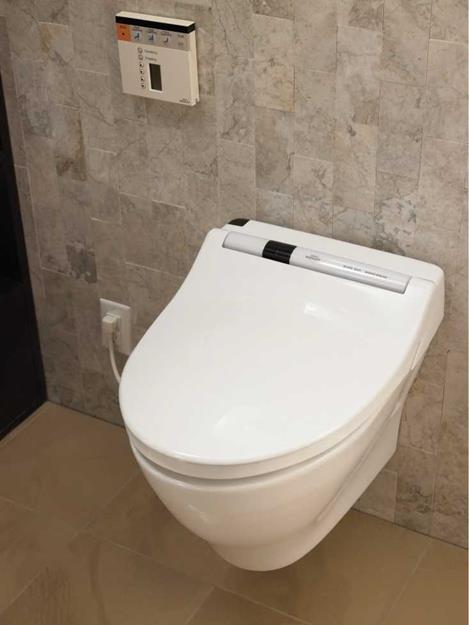 |
Appropriate size and space are provided for approach, reach, manipulation, and use, regardless of the user’s body size, posture, or mobility. Design provides a clear line of sight to important elements for any seated or standing user. Reach to all components is comfortable for any seated or standing user. Variations in hand and grip size are accommodated. There is adequate space for the use of assistive devices or personal assistance.
 |
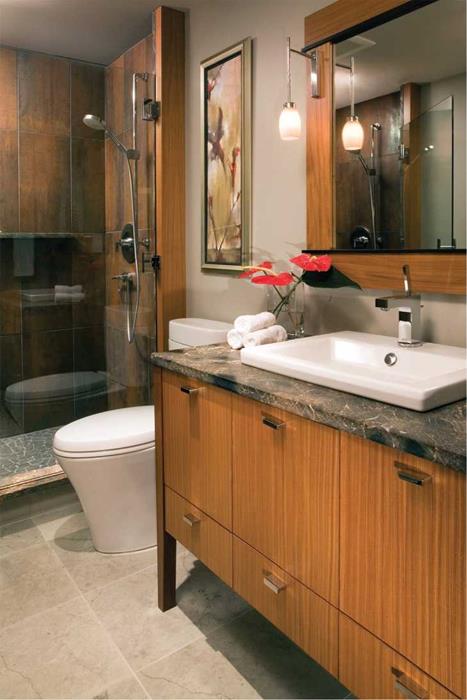 |
Design applications include full-height mirrors, movable (portable) storage, knee space (see Figure 4.21) at a the vanity and/or the lavatory, and private toilet compartments that incorporate 48 inches by 30 inches (1219 mm by 762 mm) of clear floor space.
The field of universal design represents a convergence of several threads of design practice with a focus on usefulness. To this end, the State University of New York (SUNY) at Buffalo is home to the Center for Inclusive Design and Environmental Access, the IDEA Center, an excellent source of information on the current state of universal design. Both the IDEA Center and the recently published book, Universal Design: Creating Inclusive Environments, are good sources of information on global and national movement in universal design.
 |
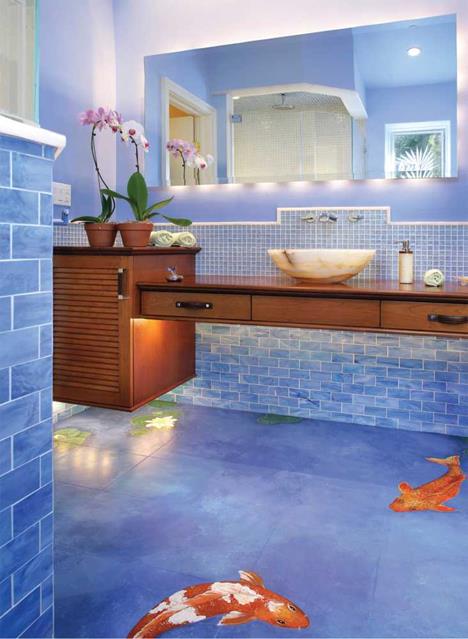 |
The term "universal design" is sometimes inaccurately used as the politically correct description of compliance with the Americans with Disabilities Act (ADA) and other access standards or guidelines. While access standards and guidelines are important as a minimum, universal design is a broader approach that works to incorporate the needs of all users and is not limited to any one specific group. Universal design is an ideal, a way of thinking, whereas code compliance is often simply following a dictate.
A number of terms are used that relate to universal design but have slightly different meanings.
• Lifespan design refers to the aspect of universal design that provides for the changes that may occur in the lifespan of household members, such as the birth and growth of children, or the return home after a skiing accident that resulted in a broken bone.
• Transgenerational design refers to design that acknowledges and supports the multiple generations commonly living under one roof today.
• Barrier-free design is an older term, first used to refer to solutions that removed barriers in the environment. While removing barriers is still one important aspect, in North America universal design has been embraced as a broader, more positive approach and term. Universal design seeks to eliminate building of architectural or structural barriers that will need to be removed at a later time.
• Accessible design or accessibility refers to characteristics of spaces or products that meet prescribed requirements for particular variations in ability. It is often a function of compliance with regulations or criteria that established a minimum level of design necessary to accommodate a person with a disability, that is, "wheelchair accessible."
• Adaptable design refers to features that are either adjustable or capable of being easily added or removed to "adapt" the unit to individual needs or preferences.
• Aging-in-place (design for): Design that considers the changes that occur as one ages, supporting the ability to live in one’s own home and community safely, independently, and comfortably, regardless of age, income, or ability level.
• Visit-ability refers to basic accommodations that will allow people of differing abilities to visit a home. In terms of bath design, visit-ability requires at least one bath on the main floor, with a minimum 32-inch (813-mm) -wide clear passage at the door. In some jurisdictions, it includes requirements for clear floor space and reinforcement for possible addition of grab bars.
• FlexHousing is a Canadian concept in housing that incorporates the ability to make future changes easily and with minimum expense, to meet the evolving needs of its occupants. FlexHousing is simply an approach to designing and building homes based on the principles of adaptability, accessibility, affordability, and healthy housing.
The FlexHousing concept of accessibility is user-friendly, and its features add convenience and practicality to the functions of a home. Another consideration is the reduction of potential hazards. Although the initial cost of FlexHousing is slightly more than a conventional home, FlexHousing features recover their investment over the long-term because pre-engineered features allow for easy and inexpensive change and renovation. The integration of healthy building materials and innovative housing technology or Healthy Housing protects the health of the occupants and the environment.



